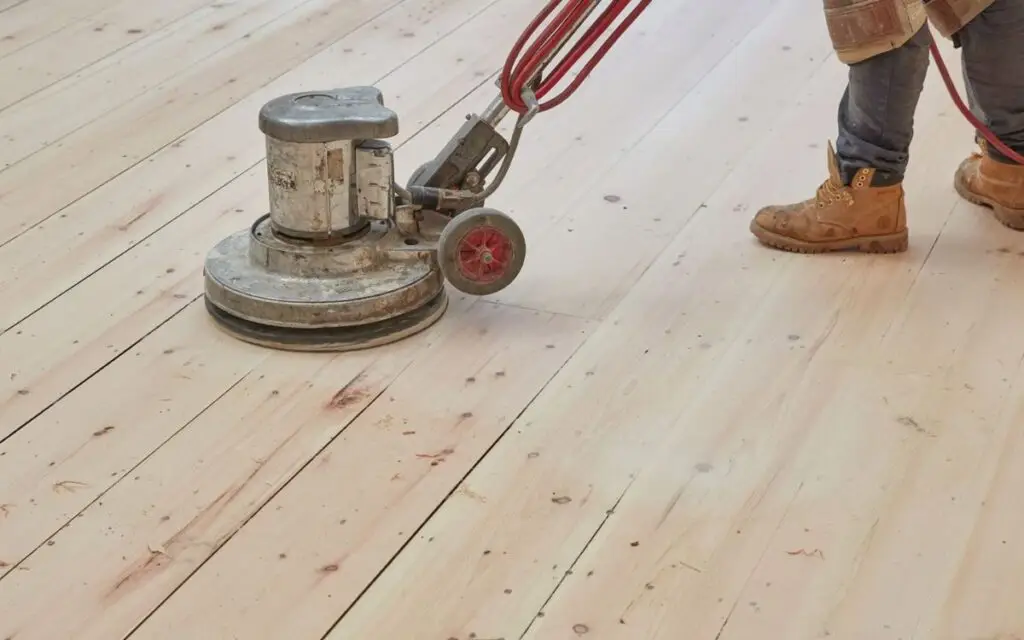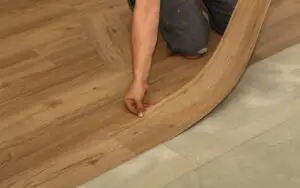Understanding the Basics: Buffing and Sanding
What is Floor Buffing?
Floor buffing is a process that involves using a specialized machine with a rotating pad to gently polish and smooth the surface of a floor. It’s primarily used to enhance the shine, remove light scratches and scuffs, and prepare the floor for a new coat of polish. Buffing is a less aggressive method compared to sanding and is suitable for maintenance rather than major restoration. While DIY buffing is possible, achieving truly professional results requires expertise and equipment that are best provided by professional floor care services.
What is Floor Sanding?
Floor sanding is a more intensive process that involves using a machine with abrasive sandpaper to remove the top layers of a floor’s surface. It’s typically used to address deep scratches, gouges, unevenness, and old finishes. Sanding is an essential step in refinishing hardwood floors and restoring them to their original condition. Due to the potential for damage and the need for specialized equipment, floor sanding is best left to experienced professionals.
Key Differences Between Buffing and Sanding
The key differences between buffing and sanding lie in their intensity and purpose. Buffing is a gentle process used for maintenance and enhancing shine, while sanding is an aggressive process used for major restoration and removing imperfections. Buffing only affects the surface layer of the floor, while sanding removes a significant portion of the floor’s material. Choosing the right method depends on the condition of your floors and the desired outcome, a decision best made with the guidance of professional floor refinishers.
When to Choose Buffing
Light Scratches and Scuffs
Buffing is an ideal solution for addressing light scratches and scuffs on your floors. The gentle abrasion of the buffing pad smooths out these minor imperfections, restoring the floor’s original shine and appearance. This is a cost-effective way to maintain the beauty of your floors without resorting to more intensive methods like sanding. Professional buffing services can quickly and efficiently remove these blemishes, leaving your floors looking refreshed and revitalized.
Enhancing Shine and Removing Residue
Buffing is also an excellent method for enhancing the shine of your floors and removing stubborn residue. Over time, floors can accumulate dirt, grime, and cleaning product residue that dulls their appearance. Buffing helps to lift away these contaminants, revealing the floor’s natural luster. Professional buffing techniques can maximize the shine and clarity of your floors, creating a welcoming and aesthetically pleasing environment.
Preparing for a New Coat of Polish
Buffing is an essential step in preparing floors for a new coat of polish. By smoothing the surface and removing any existing imperfections, buffing ensures that the new polish adheres properly and provides a uniform, long-lasting finish. This step is crucial for achieving a professional-quality result and maximizing the lifespan of your floor polish. Professional floor polishing services understand the importance of proper surface preparation and can ensure that your floors are perfectly prepped for a new coat of polish.
When to Choose Sanding
Deep Scratches and Gouges
Sanding is the appropriate choice for addressing deep scratches and gouges in your floors. These types of imperfections penetrate beyond the surface layer and cannot be effectively removed by buffing. Sanding removes the damaged wood, creating a smooth, even surface that can be refinished. Due to the potential for damage and the need for specialized equipment, sanding is best left to experienced professionals who can ensure a flawless restoration.
Uneven Floors and Warping
Uneven floors and warping are serious issues that require sanding to correct. These problems can be caused by moisture damage, structural issues, or simply the natural aging process of the floor. Sanding removes the high spots and levels the surface, creating a safe and aesthetically pleasing floor. This is a complex process that requires expertise and precision, making professional sanding services the best option for addressing uneven floors and warping.
Removing Old Finishes and Stains
Sanding is also necessary for removing old finishes and stains from your floors. Over time, finishes can become worn, discolored, or damaged, detracting from the appearance of your floors. Sanding strips away these old layers, revealing the raw wood beneath. This allows you to apply a new finish that complements your style and protects the floor for years to come. Professional sanding services can efficiently and effectively remove old finishes and stains, preparing your floors for a beautiful new look.
The Process of Buffing Floors
Preparing the Floor
Before buffing, the floor must be thoroughly cleaned to remove dirt, dust, and debris. Any furniture or obstacles should be removed from the area. The floor should be dry and free of any spills or stains. This initial preparation is key to achieving an even and effective buff. Professional cleaning services often include this preparation as part of their buffing process, ensuring optimal results.
Selecting the Right Buffing Pad
Choosing the right buffing pad is crucial for achieving the desired outcome. Different pads are designed for different purposes, such as removing light scratches, enhancing shine, or applying polish. Using the wrong pad can damage the floor or produce unsatisfactory results. Professional floor care providers have a variety of pads and the expertise to select the best one for your specific flooring type and needs.
Buffing Techniques for Optimal Results
Proper buffing techniques are essential for achieving a smooth, even, and shiny finish. The buffer should be moved in a consistent pattern, overlapping each pass to avoid streaks or swirl marks. The pressure applied should be even and moderate, avoiding excessive force that could damage the floor. Professional buffing technicians are trained in these techniques and can deliver consistently excellent results.
The Process of Sanding Floors
Preparing the Floor
Preparing the floor for sanding involves removing all furniture, rugs, and other obstacles from the room. The floor should be thoroughly cleaned to remove dirt, dust, and debris. Any nails or staples protruding from the surface should be hammered down or removed. This thorough preparation is essential for ensuring a smooth and even sanding process. Professional floor sanding services take great care in preparing the floor to minimize the risk of damage and maximize the quality of the final result.
Selecting the Right Sandpaper Grit
Choosing the right sandpaper grit is crucial for achieving a smooth and even surface. Coarse grits are used for removing old finishes and leveling uneven surfaces, while finer grits are used for smoothing and refining the surface. Using the wrong grit can damage the floor or produce unsatisfactory results. Professional floor sanding experts have the knowledge and experience to select the appropriate grit for each stage of the sanding process, ensuring a flawless finish.
Sanding Techniques for Achieving a Smooth Surface
Proper sanding techniques are essential for achieving a smooth and even surface. The sander should be moved in a consistent pattern, overlapping each pass to avoid streaks or gouges. The pressure applied should be even and moderate, avoiding excessive force that could damage the floor. Professional sanding technicians are trained in these techniques and can deliver consistently excellent results, creating a perfect canvas for refinishing.
DIY vs. Professional: Which is Right for You?
Assessing Your Skills and Experience
Before deciding whether to buff or sand your floors yourself, it’s essential to honestly assess your skills and experience. Both buffing and sanding require a certain level of expertise and attention to detail to achieve satisfactory results. If you have limited experience with these types of projects, it may be best to leave it to the professionals. Professional floor refinishers have the knowledge, skills, and equipment to handle even the most challenging floor restoration projects.
Equipment Rental and Costs
Renting the necessary equipment for buffing or sanding can be expensive, especially if you only plan to use it once. The cost of renting a buffer or sander can easily exceed the cost of hiring a professional for a small project. Additionally, you’ll need to factor in the cost of sandpaper, buffing pads, and other supplies. When you consider the total cost of equipment rental and supplies, professional floor care services may be a more cost-effective option.
Risks of DIY Sanding and Buffing
DIY sanding and buffing projects carry several potential risks, including damage to the floor, personal injury, and unsatisfactory results. Improper use of equipment, lack of experience, and failure to follow safety precautions can all lead to costly mistakes. Professional floor refinishers have the training and experience to minimize these risks and ensure a safe and successful outcome.
Potential Pitfalls of DIY Floor Work
Uneven Sanding and Swirl Marks
One of the most common pitfalls of DIY floor work is uneven sanding, which can result in swirl marks and an inconsistent finish. This is often caused by improper technique or using the wrong type of sandpaper. Repairing uneven sanding can be costly and time-consuming, often requiring the expertise of a professional floor sanding specialist.
Damage to the Floor Surface
Another potential pitfall of DIY floor work is damage to the floor surface. Using excessive pressure or the wrong type of equipment can gouge or scratch the floor, causing permanent damage. Professional floor refinishers have the knowledge and experience to avoid these types of mistakes and ensure a safe and successful outcome.
Health and Safety Concerns
DIY floor work can also pose several health and safety concerns. Sanding and buffing can generate a significant amount of dust, which can be harmful to breathe. It’s important to wear a respirator and eye protection to avoid inhaling dust and debris. Additionally, improper use of equipment can lead to personal injury. Professional floor refinishers are trained in safety procedures and use specialized equipment to minimize these risks.
The Benefits of Professional Floor Refinishing
Expertise and Experience
One of the primary benefits of hiring a professional floor refinisher is their expertise and experience. They have the knowledge and skills to assess the condition of your floors, recommend the appropriate treatment, and execute the work flawlessly. This expertise can save you time, money, and frustration in the long run.
Professional Equipment and Techniques
Professional floor refinishers use specialized equipment and techniques to achieve superior results. They have access to high-quality sanders, buffers, and finishes that are not typically available to homeowners. They also have the training to use these tools effectively and efficiently, ensuring a smooth, even, and long-lasting finish.
Guaranteed Results and Customer Satisfaction
When you hire a professional floor refinisher, you can expect guaranteed results and customer satisfaction. They stand behind their work and will take the necessary steps to ensure that you are completely happy with the outcome. This peace of mind is invaluable and can justify the cost of hiring a professional.
Comparing Costs: DIY vs. Professional Floor Care
Initial Investment and Long-Term Maintenance
Comparing the costs of DIY versus professional floor care requires considering both the initial investment and long-term maintenance. DIY projects may seem cheaper initially, but the cost of equipment rental, supplies, and potential mistakes can quickly add up. Professional floor care services may have a higher upfront cost, but they provide a long-lasting, durable finish that requires less frequent maintenance, potentially saving you money in the long run.
Hidden Costs of DIY Mistakes
One of the biggest risks of DIY floor work is the potential for costly mistakes. Uneven sanding, damage to the floor surface, and improper application of finishes can all lead to expensive repairs. Professional floor refinishers have the expertise and experience to avoid these types of mistakes, saving you time, money, and frustration.
Value of Professional Services
The value of professional floor care services extends beyond the cost of the materials and labor. Professionals provide expertise, quality workmanship, and peace of mind. They can assess the condition of your floors, recommend the appropriate treatment, and execute the work flawlessly. By investing in professional floor care, you can protect your investment and enjoy beautiful, long-lasting floors for years to come.
Case Studies: Buffing vs. Sanding Success Stories
Residential Homes
Numerous case studies highlight the success of both buffing and sanding in residential homes. For example, a homeowner with lightly scratched hardwood floors opted for professional buffing, which restored the shine and appearance of the floors at a fraction of the cost of sanding. Another homeowner with deeply gouged and stained floors chose professional sanding and refinishing, which completely transformed the floors and added significant value to the home.
Commercial Spaces
Commercial spaces also benefit greatly from professional buffing and sanding services. For instance, a retail store with high-traffic floors used regular buffing to maintain the shine and appearance of the floors, preventing the need for more costly sanding and refinishing. A restaurant with heavily damaged floors opted for professional sanding and refinishing, which created a welcoming and aesthetically pleasing environment for customers.
Long-Term Results and Customer Testimonials
Long-term results and customer testimonials consistently demonstrate the value of professional buffing and sanding services. Homeowners and business owners alike rave about the improved appearance, durability, and value of their floors after undergoing professional treatment. These testimonials serve as a testament to the expertise, quality, and dedication of professional floor care providers.
FAQs & Answers
Yes, it is possible to buff your floors too much. Over-buffing can wear down the finish, leading to dullness or even damage to the underlying wood. The key is to understand the limits of your floor's finish and to use appropriate buffing techniques. Professionals are trained to assess the condition of the finish and apply the right amount of buffing to achieve optimal results without causing harm. They can also recommend a maintenance schedule to prevent over-buffing and keep your floors looking their best. Therefore, while DIY buffing might seem straightforward, entrusting the task to professionals ensures your floors are treated with the right care and expertise.
No, sanding is not always necessary before refinishing hardwood floors. The decision to sand depends on the condition of the existing finish. If the finish is in relatively good shape with only minor scratches or wear, a process called "screening" or light abrasion may be sufficient to prepare the surface for a new coat of finish. However, if the existing finish is severely damaged, peeling, or uneven, sanding is typically required to remove the old finish and create a smooth, even surface for the new finish to adhere to. Professionals can accurately assess the condition of your floors and determine the most appropriate method for refinishing, saving you time and money by avoiding unnecessary sanding.
Buffing and sanding floors require specialized equipment that can be costly to purchase. For buffing, you'll need a floor buffer with various buffing pads. For sanding, you'll need a floor sander, which comes in different types such as drum sanders, orbital sanders, and edge sanders, along with various grits of sandpaper. Each type of equipment requires specific knowledge and techniques to operate safely and effectively. Professionals invest in high-quality equipment and undergo training to ensure they can deliver consistent, high-quality results. Therefore, hiring professionals not only saves you the expense of purchasing equipment but also ensures the job is done right, minimizing the risk of damage to your floors.
Determining whether your floors need buffing or sanding depends on the extent of the damage. If your floors have only minor scratches, scuffs, or a dull appearance, buffing is likely sufficient to restore their shine. However, if your floors have deep scratches, gouges, unevenness, or an old, damaged finish, sanding is necessary to remove the imperfections and prepare the surface for refinishing. Professionals can accurately assess the condition of your floors and recommend the most appropriate treatment based on their expertise and experience. Their assessment can save you time and money by avoiding unnecessary or ineffective treatments.
Buffing is generally not effective at removing stains from floors, as it only addresses surface imperfections. Sanding, on the other hand, can remove some stains, but its effectiveness depends on the depth and severity of the stain. Deeply penetrated stains may require specialized stain removal techniques or even replacement of the affected boards. Professionals have the knowledge and tools to assess the type and severity of stains and recommend the most appropriate course of action. They can also advise you on preventative measures to avoid future staining, ensuring your floors remain beautiful and stain-free.





